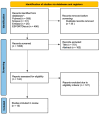Association of Physical and Emotional Parameters with Performance of Firefighters: A Systematic Review
- PMID: 39200706
- PMCID: PMC11354647
- DOI: 10.3390/ijerph21081097
Association of Physical and Emotional Parameters with Performance of Firefighters: A Systematic Review
Abstract
Firefighting requires a high level of physical fitness and causes substantial psychological stress, engendering musculoskeletal, mental, and cardiac issues. Consequently, it is necessary to measure the preparation of the firefighters daily through the Firefighting Physical Ability Tests (FPATs). According to the literature, some variables are more important for performance in the FPAT. Therefore, we aimed to summarize evidence that relates physical and mental aspects to the FPAT performance. We used the Preferred Reporting Items for Systematic Reviews and Meta-Analysis (PRISMA) method, screening 1055 records from databases and selecting 15 that met inclusion criteria. No emotional and psychological variables were correlated with the FPAT. Most research shows significant correlations between the FPAT performance and the following: aerobic fitness, upper body endurance and strength, anaerobic capacity, body fat, and age. Lower body endurance and strength, as well as anaerobic power, had a low number of investigations and need to be further explored. Abdominal endurance showed weak correlations, while flexibility did not show any correlations in most studies, although these should be considered for injury prevention. We recommend that fitness programs and evaluations include a global analysis considering the evidence presented for methodological improvements.
Keywords: firefighter performance; firefighting physical ability test; mental demands; physical demands.
Conflict of interest statement
The authors declare no conflicts of interest.
References
-
- Antolini M.R., Weston Z.J., Tiidus P.M. Physical Fitness Characteristics of a Front-Line Firefighter Population. Acta Kinesiol. Univ. Tartu. 2015;21:61–74. doi: 10.12697/akut.2015.21.06. - DOI
Publication types
MeSH terms
Grants and funding
LinkOut - more resources
Full Text Sources
Medical
Miscellaneous


